陈凯迪的实验6
一、实验结论
1.1
代码:

1 #include <stdio.h> 2 #define N 4 3 4 int main() 5 { 6 int x[N] = {1, 9, 8, 4}; 7 int i; 8 int *p; 9 10 // ��ʽ1��ͨ�����������±�����������Ԫ�� 11 for(i=0; i<N; ++i) 12 printf("%d", x[i]); 13 printf("\n"); 14 15 // ��ʽ2��ͨ��ָ����������������Ԫ�� ��д��1�� 16 for(p=x; p<x+N; ++p) 17 printf("%d", *p); 18 printf("\n"); 19 20 // ��ʽ2��ͨ��ָ����������������Ԫ�أ�д��2�� 21 p = x; 22 for(i=0; i<N; ++i) 23 printf("%d", *(p+i)); 24 printf("\n"); 25 26 // ��ʽ2��ͨ��ָ����������������Ԫ�أ�д��3�� 27 p = x; 28 for(i=0; i<N; ++i) 29 printf("%d", p[i]); 30 printf("\n"); 31 32 return 0; 33 }
图片:

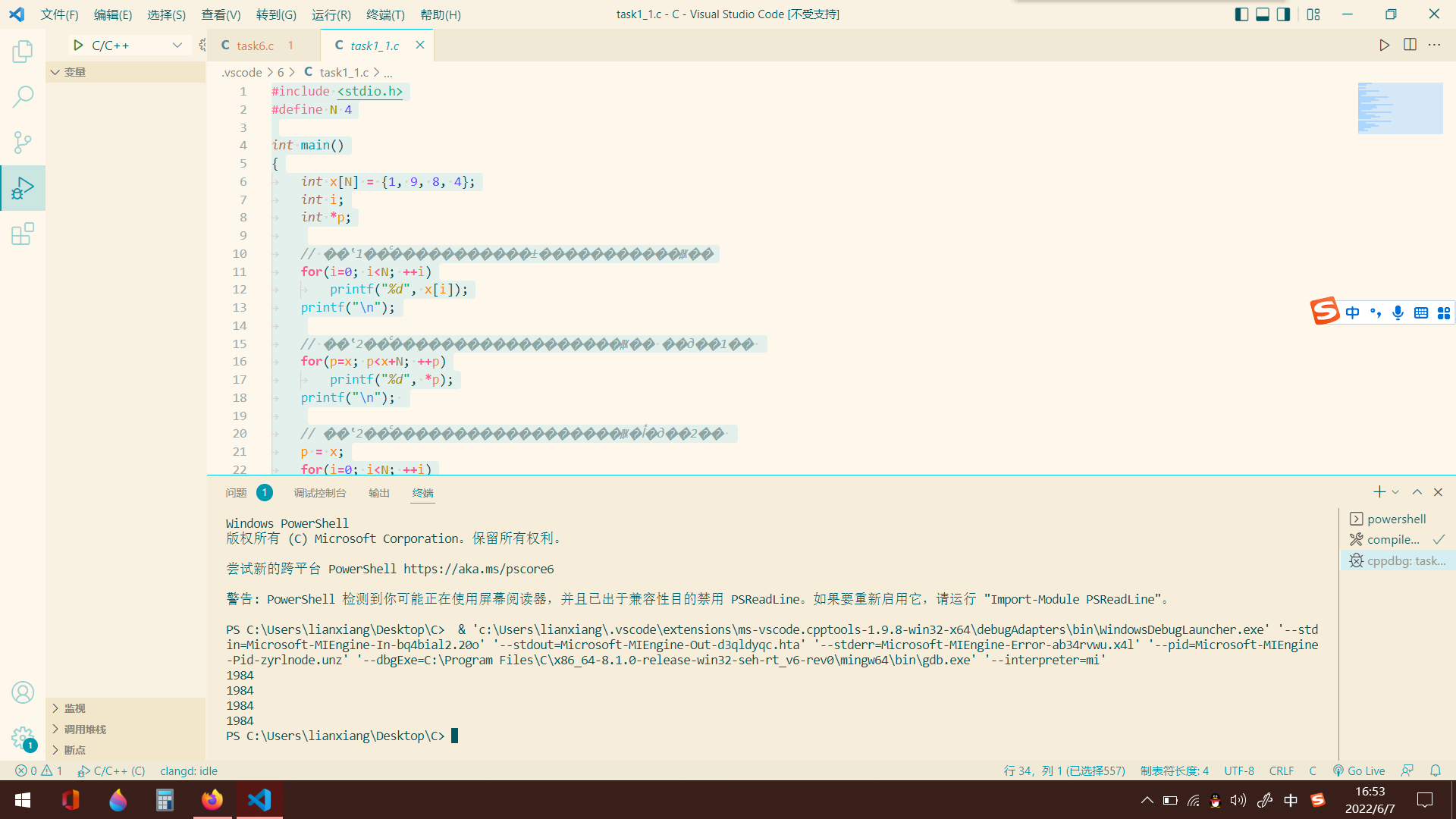
1.2
代码:

1 #include <stdio.h> 2 #define N 4 3 4 int main() 5 { 6 char x[N] = {'1', '9', '8', '4'}; 7 int i; 8 char *p; 9 10 // ��ʽ1��ͨ�����������±�����������Ԫ�� 11 for(i=0; i<N; ++i) 12 printf("%c", x[i]); 13 printf("\n"); 14 15 // ��ʽ2��ͨ��ָ����������������Ԫ�� ��д��1�� 16 for(p=x; p<x+N; ++p) 17 printf("%c", *p); 18 printf("\n"); 19 20 // ��ʽ2��ͨ��ָ����������������Ԫ�أ�д��2�� 21 p = x; 22 for(i=0; i<N; ++i) 23 printf("%c", *(p+i)); 24 printf("\n"); 25 26 // ��ʽ2��ͨ��ָ����������������Ԫ�أ�д��3�� 27 p = x; 28 for(i=0; i<N; ++i) 29 printf("%c", p[i]); 30 printf("\n"); 31 32 return 0; 33 }
图片:


1.3
回答:1:2004 2:2008 3:指针所指向的地址存放的值的类型不同,int占4bit而char占8bit。
2.1
代码:

1 #include <stdio.h> 2 3 int main() 4 { 5 int x[2][4] = { {1,9,8,4}, {2,0,2,2}} ; 6 int i, j; 7 int *p; // ָ����������int�������ݵĵ�ַ 8 int (*q)[4]; // 9 10 // ʹ�����������±���ʶ�ά����Ԫ�� 11 for(i=0; i<2; ++i) 12 { 13 for(j=0; j<4; ++j) 14 printf("%d", x[i][j]); 15 printf("\n"); 16 } 17 18 // ʹ��ָ�����p��ӷ��ʶ�ά����Ԫ�� 19 for(p = &x[0][0], i = 0; p < &x[0][0] + 8; ++p, ++i) 20 { 21 printf("%d", *p); 22 if( (i+1)%4 == 0) 23 printf("\n"); 24 } 25 26 // ʹ��ָ�����q��ӷ��ʶ�ά����Ԫ�� 27 for(q=x; q<x+2; ++q) 28 { 29 for(j=0; j<4; ++j) 30 printf("%d", *(*q+j)); 31 printf("\n"); 32 } 33 34 return 0; 35 }
图片:

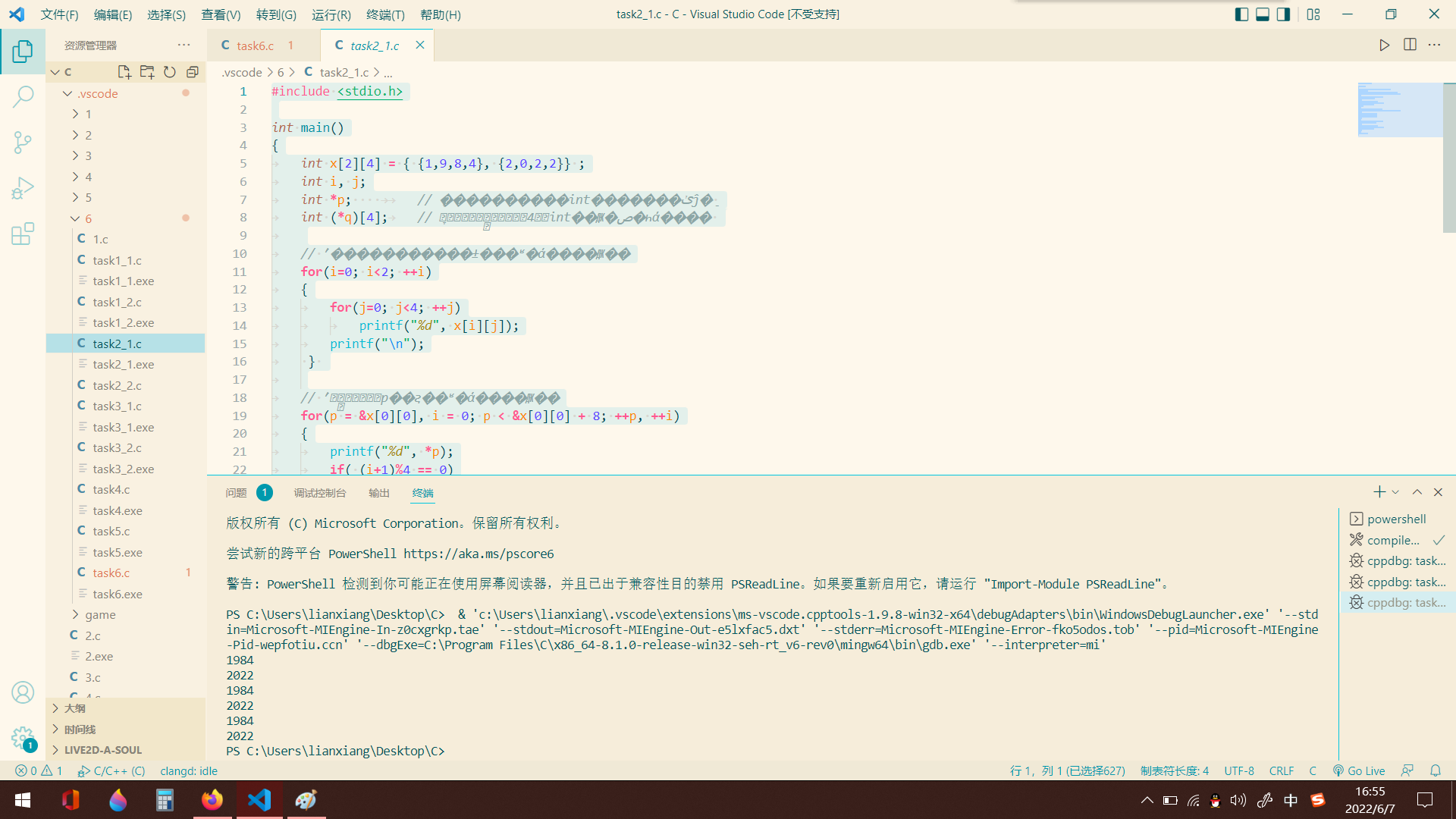
2.2
代码:

1 #include <stdio.h> 2 3 int main() 4 { 5 char x[2][4] = { {'1', '9', '8', '4'}, {'2', '0', '2', '2'} }; 6 int i, j; 7 char *p; 8 char (*q)[4]; 9 10 11 for(i=0; i<2; ++i) 12 { 13 for(j=0; j<4; ++j) 14 printf("%c", x[i][j]); 15 printf("\n"); 16 } 17 18 19 for(p = &x[0][0], i = 0; p < &x[0][0] + 8; ++p, ++i) 20 { 21 printf("%c", *p); 22 if( (i+1)%4 == 0) 23 printf("\n"); 24 } 25 26 27 for(q=x; q<x+2; ++q) 28 { 29 for(j=0; j<4; ++j) 30 printf("%c", *(*q+j)); 31 printf("\n"); 32 } 33 34 return 0; 35 }
图片:


2.3
回答:1:2004、2016 2:2008、2032 3:列指针每次指向下一个、行指针每次指向下一行。
3.1
代码:

1 #include <stdio.h> 2 #include <string.h> 3 #define N 80 4 5 int main() 6 { 7 char s1[] = "C, I love u."; 8 char s2[] = "C, I hate u."; 9 char tmp[N]; 10 11 printf("sizeof(s1) vs. strlen(s1): \n"); 12 printf("sizeof(s1) = %d\n", sizeof(s1)); 13 printf("strlen(s1) = %d\n", strlen(s1)); 14 15 printf("\nbefore swap: \n"); 16 printf("s1: %s\n", s1); 17 printf("s2: %s\n", s2); 18 19 printf("\nswapping...\n"); 20 strcpy(tmp, s1); 21 strcpy(s1, s2); 22 strcpy(s2, tmp); 23 24 printf("\nafter swap: \n"); 25 printf("s1: %s\n", s1); 26 printf("s2: %s\n", s2); 27 28 return 0; 29 }
图片:

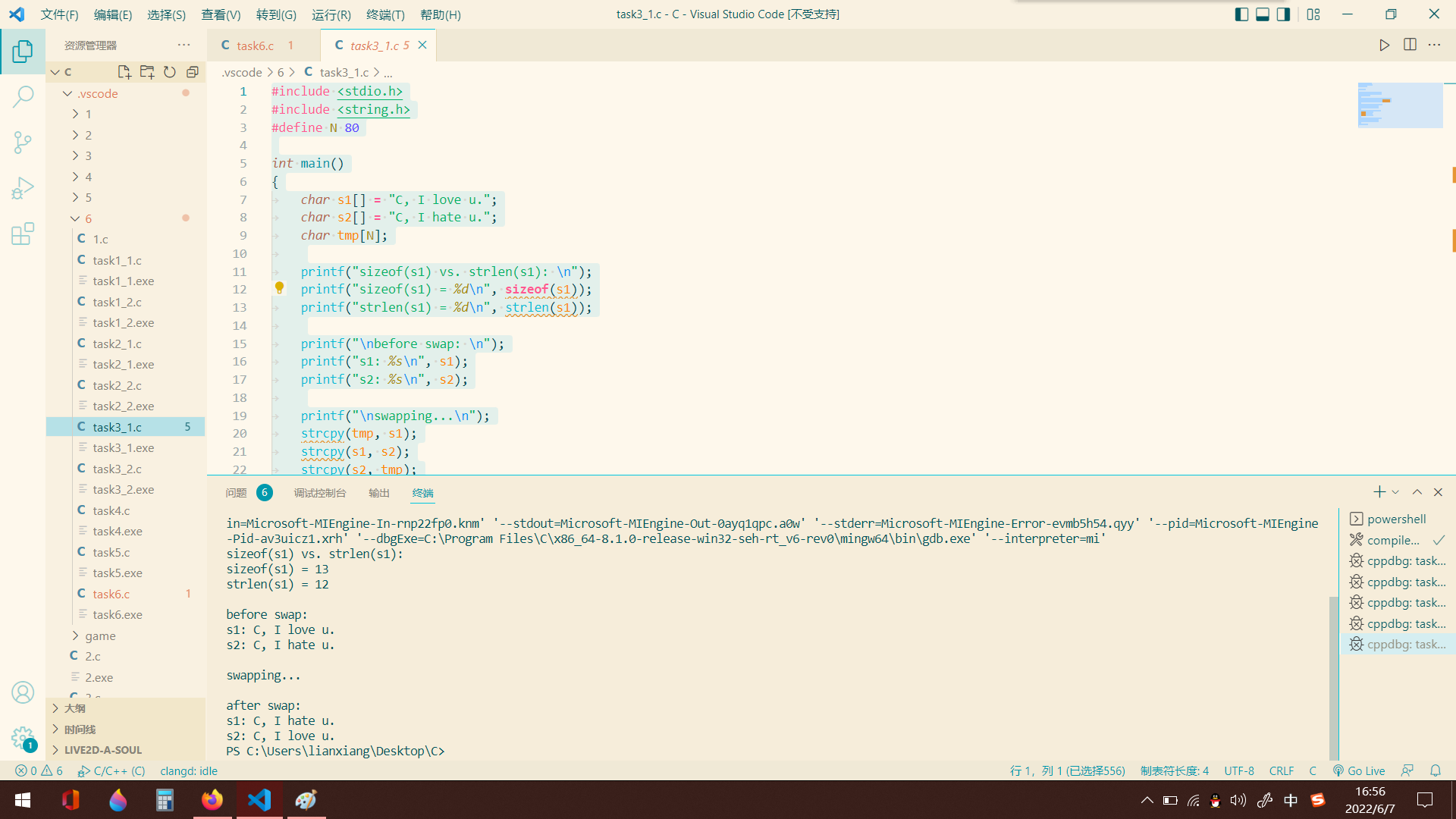
3.2
代码:

1 #include <stdio.h> 2 #include <string.h> 3 #define N 80 4 5 int main() 6 { 7 char *s1 = "C, I love u."; 8 char *s2 = "C, I hate u."; 9 char *tmp; 10 11 printf("sizeof(s1) vs. strlen(s1): \n"); 12 printf("sizeof(s1) = %d\n", sizeof(s1)); 13 printf("strlen(s1) = %d\n", strlen(s1)); 14 15 printf("\nbefore swap: \n"); 16 printf("s1: %s\n", s1); 17 printf("s2: %s\n", s2); 18 19 printf("\nswapping...\n"); 20 tmp = s1; 21 s1 = s2; 22 s2 = tmp; 23 24 printf("\nafter swap: \n"); 25 printf("s1: %s\n", s1); 26 printf("s2: %s\n", s2); 27 28 return 0; 29 }
图片:

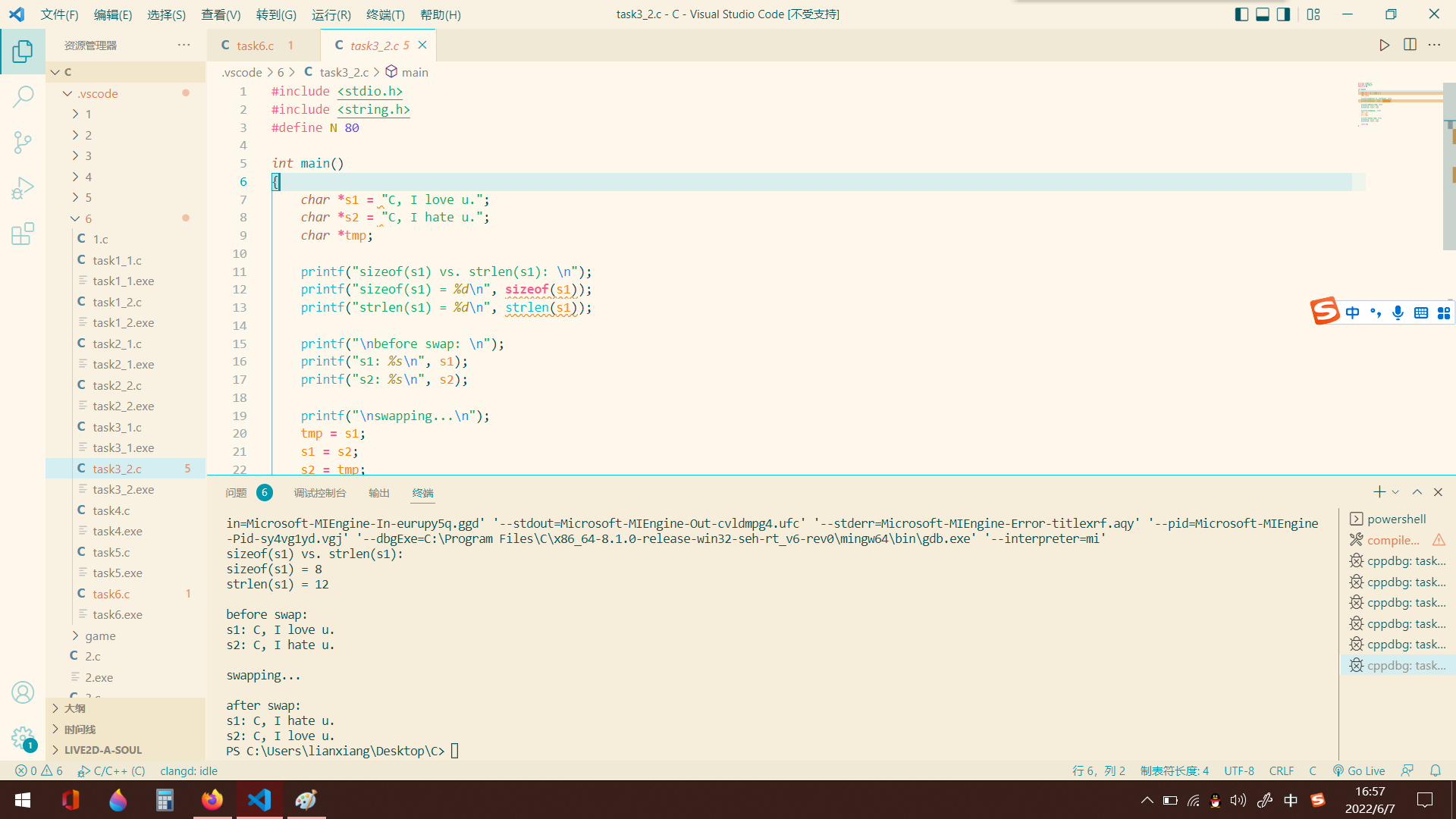
3.3
回答:1、 1)13、数组的长度、字符串的长度 2)不能 3)是。
2、 1)字符串的地址、指针的长度(CPU总线的宽度)、字符串的长度 2)不能 3)交换两个指针指向的地址、内存存储没有交换。
4.1
代码:

1 #include <stdio.h> 2 #include <string.h> 3 #define N 5 4 5 int check_id(char *str); // �������� 6 7 int main() 8 { 9 char *pid[N] = {"31010120000721656X", 10 "330106199609203301", 11 "53010220051126571", 12 "510104199211197977", 13 "53010220051126133Y"}; 14 int i; 15 16 for(i=0; i<N; ++i) 17 if( check_id(pid[i]) ) // �������� 18 printf("%s\tTrue\n", pid[i]); 19 else 20 printf("%s\tFalse\n", pid[i]); 21 22 return 0; 23 } 24 25 // �������� 26 // ����: ���ָ��strָ�������֤���봮��ʽ���Ƿ�Ϸ��� 27 // ��ʽ�Ϸ�������1��������0 28 int check_id(char *str) 29 { 30 char *p; 31 int i=0; 32 p =str; 33 while(*p){ 34 if(*p>='0'&&*p<='9'||*p=='X') 35 i++; 36 p++; 37 } 38 if(i==18) 39 return 1; 40 else 41 return 0; 42 }
图片:

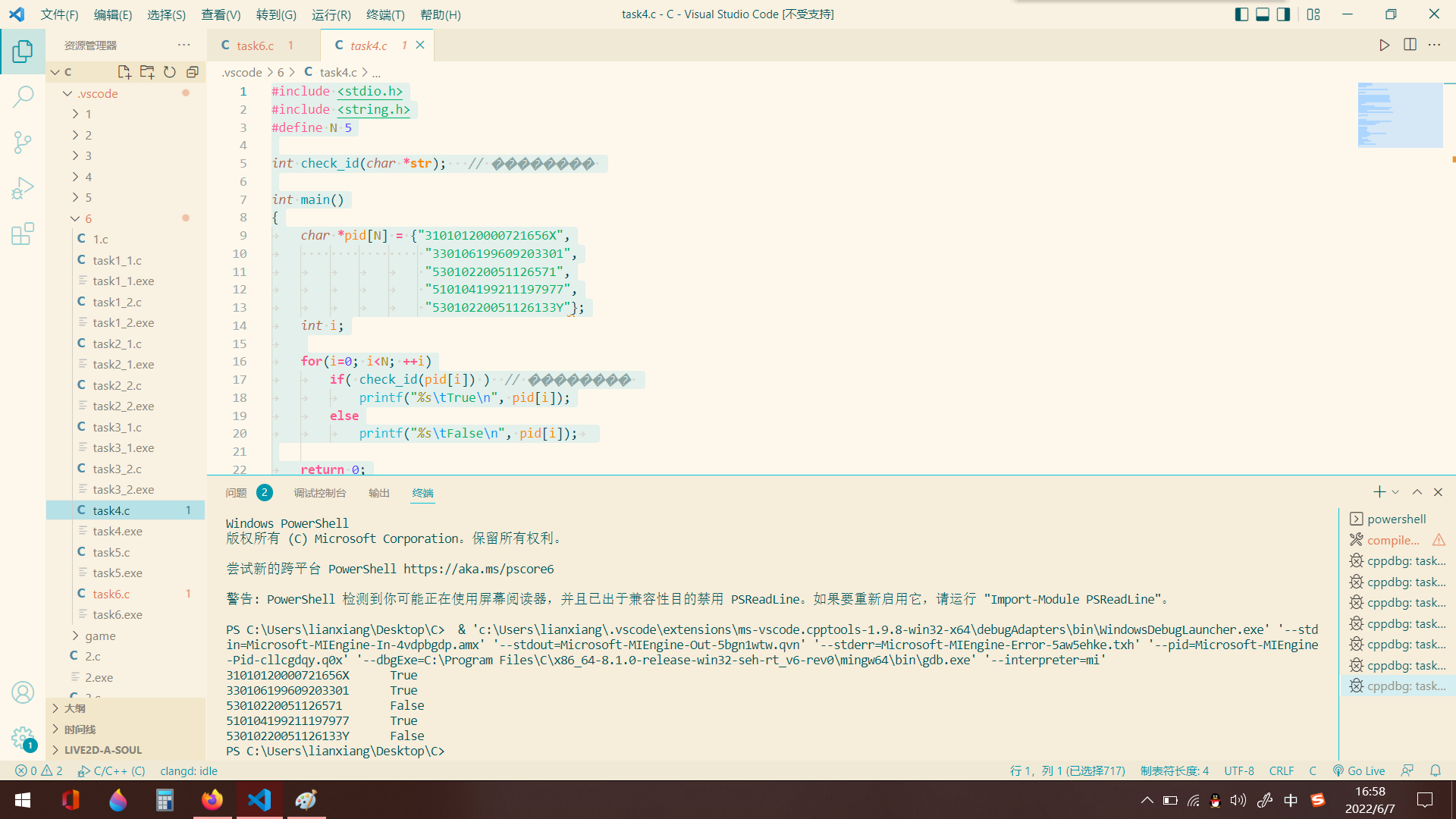
5
代码:

1 #include <stdio.h> 2 #include <string.h> 3 4 #define N 80 5 int is_palindrome(char *s); // �������� 6 7 int main() 8 { 9 char str[N]; 10 int flag; 11 12 printf("Enter a string:\n"); 13 gets(str); 14 15 flag = is_palindrome(str); // �������� 16 17 if (flag) 18 printf("YES\n"); 19 else 20 printf("NO\n"); 21 22 return 0; 23 } 24 25 // �������� 26 // ���ܣ��ж�sָ����ַ����Ƿ��ǻ��Ĵ� 27 // ����ǣ�����1��������0 28 int is_palindrome(char *s) 29 { 30 char *p,*q; 31 q=s+strlen(s)-1; 32 p=s; 33 while(p<q){ 34 if(*p!=*q) 35 break; 36 p++; 37 q--; 38 } 39 if(p>=q) 40 return 1; 41 else 42 return 0; 43 }
图片:


6
代码:

1 #include <stdio.h> 2 #define N 80 3 void encoder(char *s); // �������� 4 void decoder(char *s); // �������� 5 6 int main() 7 { 8 char words[N]; 9 10 printf("English: "); 11 gets(words); 12 13 printf("encoding: "); 14 encoder(words); // �������� 15 printf("%s\n", words); 16 17 printf("decoding: "); 18 decoder(words); // �������� 19 printf("%s\n", words); 20 21 return 0; 22 } 23 24 25 26 void encoder(char *s) 27 { 28 char *p; 29 p=s; 30 while(*p){ 31 if(*p>=65&&*p<=89||*p>=97&&*p<=121) 32 *p+=1; 33 else if(*p==90||*p==122) 34 *p-=25; 35 p++; 36 } 37 } 38 39 40 41 void decoder(char *s) 42 { 43 char *p; 44 p=s; 45 while(*p){ 46 if(*p>=66&&*p<=90||*p>=98&&*p<=122) 47 *p-=1; 48 else if(*p==65||*p==97) 49 *p+=25; 50 p++; 51 } 52 }
图片:


二、实验总结
增加了关于指针的知识,了解了sizeof(指针)的真正含义,加深了关于列指针和行指针的概念。
另:端午快乐:)





 浙公网安备 33010602011771号
浙公网安备 33010602011771号